How to Use Pinterest for Business: 8 Strategies You Need to Know
With 200 million monthly users, Pinterest may not be a social media behemoth like Facebook, but it’s an important social platform with deep penetration in valuable demographics. Half of all U.S. millennials use Pinterest, for instance. But it’s not just young people saving their ideas on the network: 68 percent of U.S. women between the ages of 25 and 54 use Pinterest, too. And while it’s true that the network does have more female users than male, 40 percent of new users are men.
If you don’t have a solid plan in place for how to use Pinterest as part of your business strategy, you’re missing out on key opportunities to reach potential new customers.
Bonus: Download our free guide that shows you how to 10X your social media performance and beat your competitors. Includes the tools, tricks, and daily routines used by three world-class social media experts.
Why use Pinterest for business?
People use Pinterest for different reasons than they use networks like Facebook and Instagram. Pinterest is a network where people look for inspiration, including specifically seeking out ideas about new products to buy. According to eMarketer, only Facebook outranks Pinterest in terms of influencing U.S. social media users’ purchasing decisions.
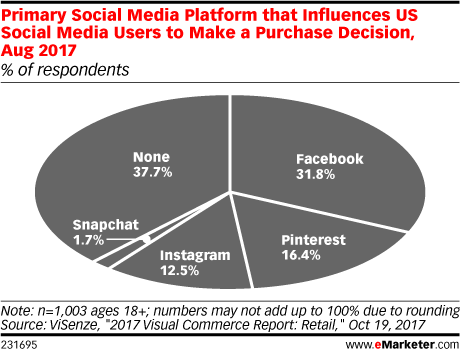
More than two-thirds of Pinners say they’ve discovered a new brand or product on Pinterest, and a whopping 93 percent of Pinners (yes, that’s almost all of them) use the network to plan purchases.
And it’s not just planning. Half of Pinners have actually made a purchase after seeing a Promoted Pin, and two-thirds look at saved Pins while out shopping in brick-and-mortar stores.
Pinterest for Business overview
Since Pinterest is a little different from the other social networks, before we talk about how to use Pinterest for business, here’s quick overview of some key Pinterest terminology.
Pins
A Pin is simply any image or video that someone chooses to save to Pinterest. For businesses, more important than the image itself is the link: Every pin links back to the original source, so Pinterest can be a great source of referral traffic.
Boards
Pinterest users (called “Pinners”) save a lot of stuff—an incredible 100 billion Pins to date. In order to keep things organized, they sort their Pins into collections called boards. For example, boards from the Hootsuite Pinterest account include case studies, best practices & trends, and infographics.
Pinners can follow your entire account, or just the specific boards that interest them most. Then, the Pins you save will appear in their feed.
Feed
A Pinterest feed is just like a feed on any other social network—it’s a collection of links and content from boards and users that the Pinner has followed.
How to set up a Pinterest account for your business
If you plan to use Pinterest to market your business, you should create a Pinterest business account, rather than a personal account. Business accounts offer business-specific features like analytics and the ability to use Pinterest advertising.
If you already have a personal Pinterest account, you can convert it to a business account. You’ll just need to fill in some additional information about your business and accept the business-specific terms of service.
If you don’t already have a Pinterest account, here’s how to create one for your business.
Step 1: Create your Pinterest for business account
- Go to to the Pinterest for business page and click Join as a business.
- Enter your email address, password, business name, and website, and choose which category your business falls into: professional, public figure, media, brand, retailer, online marketplace, local business, institution/non-profit, or other.
- Be sure to review the terms of service and privacy policy. Then click Create account.
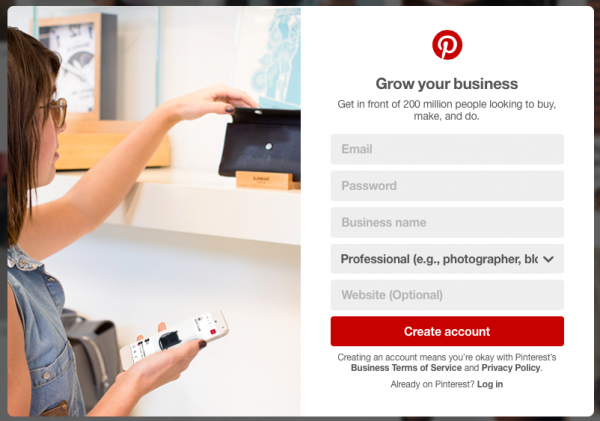
Step 2: Complete your profile
You’ve now got the bare bones of a Pinterest account, but you need to fill in your profile details to make your brand appealing and credible.
- Log into your new Pinterest account, hover over the profile icon on the top right and click Settings.
- Scroll down to the Profile section to upload a profile photo (optimal size: 165 x 165 pixels), complete the About you section, and add your business location. Then, click Save settings.

Step 3: Confirm your website
Confirming your website allows you to see what people Pin from your website, and adds your logo to any Pins made from your site. Confirming your website will also boot your Pins’ rankings in search results.
- From Pinterest settings, scroll down to the Profile section and click Confirm website.
- Copy and paste the provided text into the HTML of your website’s index page.
- Click Finish.
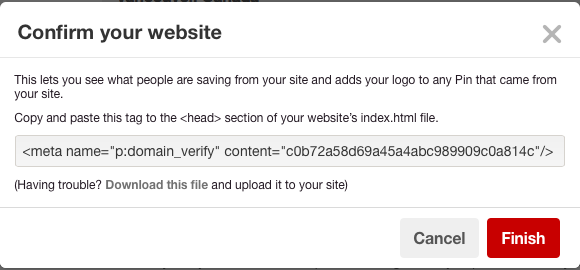
- To check whether your website is confirmed, try Pinning a link from your site. You should see your logo or profile picture below the Pin.
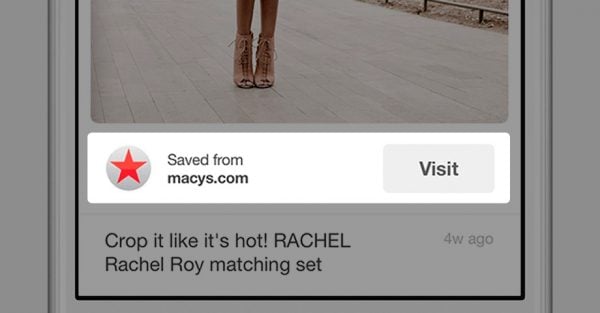
Step 4: Create boards
Now that your account is ready to go, you need to start sharing and organizing content so that Pinners will have a reason to follow either your entire account or one or more of your boards.
- From your Pinterest profile, click the Boards tab, then click the red plus sign to create a new board.
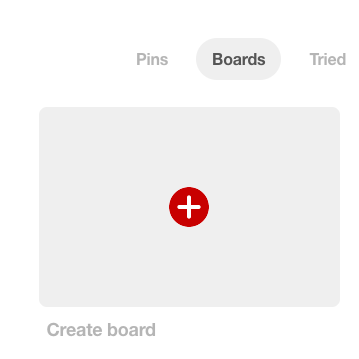
- Enter a descriptive name for your board. Use compelling but clear language to convey what you’ll Pin to the board, and keep the name to a maximum of 20 characters so it doesn’t get cut off.
- Return to the boards tab and click on the name of your new board, then click the pencil icon to enter more details.
- Enter a clear description of what you’ll save to your board, and choose an appropriate category. If you want to start saving Pins to your board but you’re not ready for people to see it yet, you can choose to make the board secret until it’s ready to go.
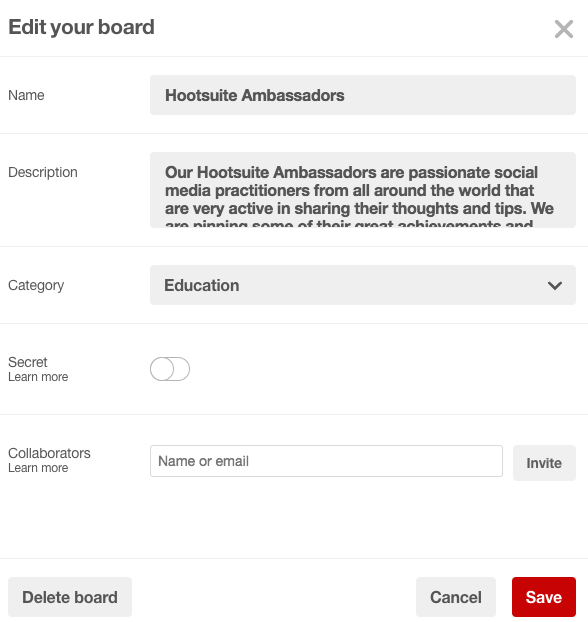
Step 5: Start Pinning
Now that you have your boards set up, it’s time to add some Pins. The easiest way to save to Pinterest quickly is to install the Pinterest browser button, which allows you to Pin anything from the web with just a couple of clicks.
- Install the appropriate Pinterest browser button for your preferred browser.
- To Pin something from the Web, click the Pinterest icon on your browser toolbar.
- Select your favorite image from the available options and click Save.
- Add or edit a description.
- Select which board to save your Pin to.
Once you have added several Pins to your board, you can choose the most visually compelling to be the cover Pin.
- From the boards tab, hover over your board and click the pencil icon on the bottom right.
- Scroll down to Cover and click Change, then scroll through to choose your cover Pin.
How to use Pinterest with Hootsuite
Save time by managing your Pinterest for business account alongside your other social profiles. From the Hootsuite dashboard you can create new boards, compose new Pins, schedule them for later, and Pin to multiple boards at once.
Using Pinterest for business: tips and tactics
1. Add save buttons to your site
If you want people to take action, you’ve got to make it easy for them to do so. Since adding a save button to your website allows people to Pin your content with just a click, even if they don’t have the Pinterest browser button installed, it should be no surprise that doing so can quintuple the amount of content Pinners save from your site.
You can choose to use automatic buttons—in which case a clickable Pinterest Save button will appear on every image on your site—or hover buttons, which will appear only when someone hovers their mouse over the images. Or, you can choose to add a Pinterest Save button only to a specific image on your site.
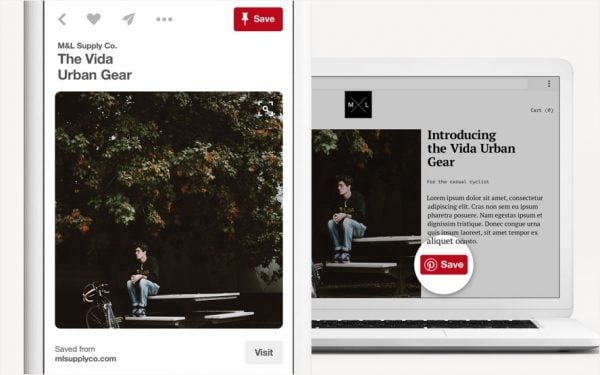
You can create your Pinterest Save buttons using the Pinterest Widget Builder. You’ll find step-by-step instructions and and learn more about how to use social save and share buttons in our post on social media buttons for every network.
2. Pin consistently
Pinterest recommends that you Pin something at least once per day, during peak times—which they’ve found to be evenings and weekends for U.S.-based brands. Pinterest also highlights that consistency is key—if you’re going to post a large number of posts over the course of a week, divide them up and post several per day rather than posting them all at once.
If you’re creating Pins to coincide with an upcoming holiday, season, or event, you should start posting them about 45 days in advance.
3. Focus on great visuals
Pinterest is a highly visual medium, so it’s worth the effort to create quality imagery. Your photos should be clear, well-lit, well-composed, and—most importantly—in focus. If you don’t have the time, the tools, or the skills to create imagery of your own, there are plenty of stock photography websites with quality photos you can use.
Think about creative ways to showcase your product and your brand visually. After studying the performance of 50,000 promoted Pins, Pinterest found that lifestyle images generally outperform product images. For instance, fashion and style Pins showing products in use in real life saw 30 percent more clickthroughs and 170 percent higher checkout rates than those showing the product alone.
For example, this Pin from Hunter Boots showcases how their boots can be worn, rather than offering a plain close-up of the boots themselves.
Eighty percent of Pinners use the Pinterest app to access the network on mobile devices, so images should be optimized for a small screen. Vertical images are your best bet, since they give you more real estate to work with. The image ratio can be up to 1:2.8, but 2:3 is ideal,which means your image should be 600 x 900 pixels. If your image is taller than 1560 pixels, it will get cut off.
Adding a few words of text to your images can help give an immediate idea of what the linked content is all about. For example, food-related Pins that include a short text call-out get 23 percent more clickthroughs and 31 percent more saves. But don’t go overboard, since Pinterest specifically recommends avoiding images that are too busy. This Pin from Kraft Foods uses just the right amount of text:
Hootsuite’s Enhance photo editor app is an easy way to add a few words of text and your logo to an image, and to automatically crop it to the optimal size for a Pin.
Finally, keep in mind that you can create multiple Pins with different images that point to the same webpage. This is not only allowed, but encouraged, since different images can appeal to different audiences.
4. But don’t neglect the words
Sure, we’ve just told you that Pinterest is a visual medium—but great visuals alone are not enough to create serious engagement. Make the most of the description field to tell viewers exactly what they will get if they click through to the linked content on your site. Make sure to include your most important keywords to help your Pins appear in search (but, of course, be sure to do this in a natural and helpful way rather than engaging in keyword stuffing).
The description in this Pin from BobVila.com incorporates some great keywords related to power outages (and the weather incidents that cause them) while still sounding like it’s written for people rather than search bots:
If you create multiple Pins with different images pointing to the same content, make sure to create a unique description for each one.
Then, make sure that linked content delivers on what you promise. Quality content will get Pinners excited about following and interacting with your brand both within and outside of Pinterest. On the other hand, Pinterest penalizes Pins with broken links, so make sure all of your Pinned links are correct and up to date.
5. Use Rich Pins when appropriate
Rich Pins are enhanced Pins that use metadata pulled from your site to provide extra information about what Pinners will find when they click on a Pin. Rich Pins are available for apps, recipes, products, and articles—in other words, they are almost certainly applicable to the content you are Pinning or hoping that others will Pin from your site.
For example, Rich Pins for articles include a headline, the name of the author, the date the article was published, and a story description. They also specifically indicate that the link points to an article, and include a call-to-action button that says “Read it.” For example, take a look at this Rich Pin saved from the Grammar Girl website:
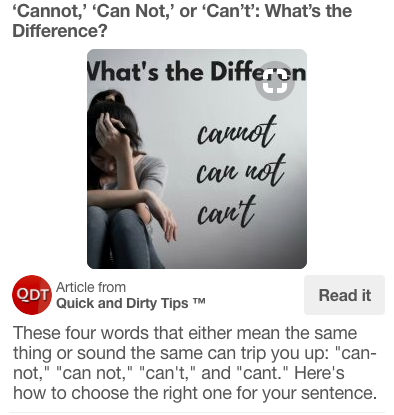
Bonus: Download our free guide that shows you how to 10X your social media performance and beat your competitors. Includes the tools, tricks, and daily routines used by three world-class social media experts.
Get the free guide right now!Follow these instructions from Pinterest to get your site set up for Rich Pins.
6. Get social
Remember: Pinterest is a social network, not a billboard. If you want people to engage with your Pins, you’ll need to be engaged yourself. Follow boards or accounts from relevant but non-competitive brands in your industry, and make sure to actively like and engage with Pins related to your niche.
You can also get employees and brand evangelists involved in your Pinterest network by inviting them to contribute to group boards. For example, Allrecipes has a board where more than 100 of its “Allrecipes Allstars” contribute Pinned recipes. The board has been a huge success for Allrecipes, attracting nearly 400,000 followers.
7. Use analytics to improve results
Pinterest Analytics provides important information about what types of content perform best on the network, so you can tweak and improve your Pinterest for business results over time. You’ll be able to see which Pins are most popular and which drive the most traffic to your site, so you can focus on the metrics that matter most to your particular business.
You’ll also see which boards your Pins are included in, which can give you a sense of how people think about your business and your products, and spark new ideas for how to position your Pinterest efforts. And you’ll get information about the demographics and interests of people who interact with your Pins, providing valuable insight to help you target your strategy to precisely the right audience.
For example, the fashion brand Reiss was surprised to learn that their menswear Pins drove more clicks and impressions than Pins of women’s clothing. They quickly revised their previously female-focused Pinterest strategy to target more men, brought in even more male followers, and saw a large jump in referral traffic to their menswear pages.
You can access Analytics directly from your profile by clicking the Analytics tab on the top left of the screen, and learn more about the details of using Pinterest Analytics to fine-tune your strategy in our post on Pinterest Analytics for business.

8. Try Pinterest ads
Promoted Pins (aka Pinterest ads) are a great way to get your Pins seen by more people, creating new exposure for your brand. But Promoted Pins can provide exposure well beyond what you pay for. Internal Pinterest data shows that advertisers get an average of 20 percent more organic clicks in the month following the launch of a Pinterest ad campaign.
Pinterest identifies Promoted Pins by placing the word “Promoted” below the Pin. Clicking on the more icon (…) brings up a statement describing who paid for the ad. For example, take a look at this Promoted Pin from Style Bistro:
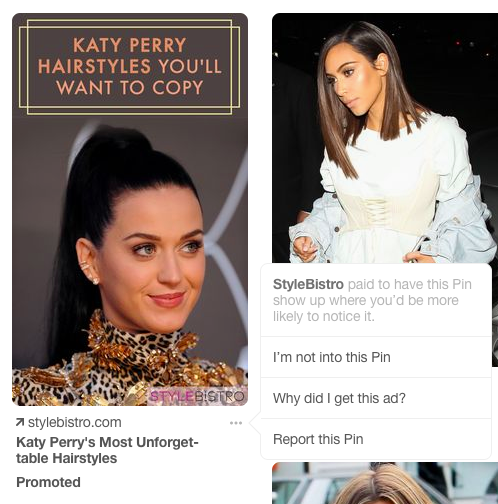
However, when Pinners save your Promoted Pins to their own boards, they become regular organic Pins, so the promotional labels are stripped out. For example, here’s what that same Pin looks like once saved to a Pinner’s board:
We walk you step-by-step through how to create a successful Pinterest ad campaign in our complete guide to Pinterest ads.
For even more Pinterest tips and best practices, check out our post highlighting ideas from top bloggers who use Pinterest as part of their business strategy.
Save time managing your Pinterest presence using Hootsuite. From a single dashboard you can compose, schedule, and publish Pins, create new boards, Pin to multiple boards at once, and run all your other social media profiles. Try it free today.
The post How to Use Pinterest for Business: 8 Strategies You Need to Know appeared first on Hootsuite Social Media Management.
Contributer : Hootsuite Social Media Management https://ift.tt/1OTBHJI
 Reviewed by mimisabreena
on
Tuesday, May 08, 2018
Rating:
Reviewed by mimisabreena
on
Tuesday, May 08, 2018
Rating:

















No comments:
Post a Comment